Updated: 08-Jul-2020
Mercedes is the name that Daimler products received at the suggestion of the car dealer in Monaco and the French Riviera in the early 20th century.
-Such was the sales success of the German car that he considered that he should change the name to a pseudonym that would make it more attractive to the customers to whom he sold them.
-Emile Jellinek, the representative of Austrian origin, was very well connected with high-level people in the area and his orders were continually increasing.
-It occurred to him to put the name of "Mercedes" to the vehicles after agreement with Daimler.
-Mercedes was the name of his 10-year-old daughter.
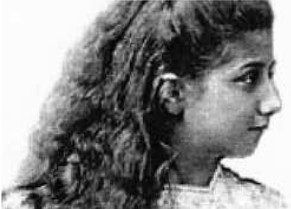
“Mercedes Jellinek”
-Mercedes started in aviation by adapting car engines and derivatives, making the heavier ones lighter.
-Initially there were 3 main types, the 45 CV, the 75 CV and the 125 CV for airplanes and seven types for airships from 30 to 180 CV.
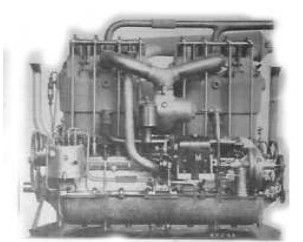
“Mercedes 45 CV”
-Around 1909 Mercedes and therefore Daimler began working on a 45 CV 4-cylinder with pistons of 110 mm bore and 140 mm stroke, rotating at 1,200 maximum rpm.
-The cylinders were cast in pairs, with a camshaft and outer distributor on the propeller side.
-The ignition timing was controlled by the pilot.
-The engine with pumps, carburetor, magnetos, wiring and spark plugs weighed 120 Kgs.
-The flywheel had a fan to force air into the radiator.
-Only the flywheel weighed 15 Kgs.
-In running order with radiator, water, oil and gasoline, the weight increased to 183 Kgs.
-It was in the beginning and therefore the weight of less than one Kg per CV was still far away.
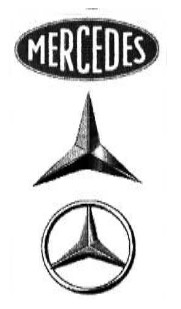
“Mercedes logos”
-The 75 CV was the E4F with pistons of 120 mm bore by 140 mm stroke.
-The four-cylinder J4L also but with 120 CV at 1,100 rpm, weighing 660 pounds, or 5.5 pounds per CV. This engine was used on airships.
-The 70 CV 4EF type was made with inverted cylinders. It was also water cooled.

“Mercedes 4EF”
-The J8L was an 8-cylinder in-line with the same cylinders as the J4L, displacing 1,668 cu. in.
-There was the other 8-cylinder engine from the same era that gave 240 CV and was used on airships. See D-IV.
-Two illustrations are provided below, for both sides of the 240 CV engine, the Typ J8L.
-It was mounted on the Schütte-Lanz “S.L.-1” airships.
-It was a very long engine with eight in-line cylinders in paired blocks.
-Sometimes Mercedes-Daimler (see).
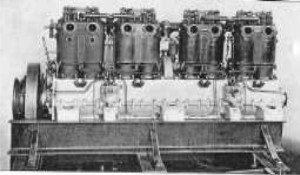
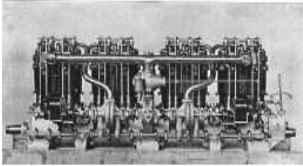
“Mercedes J8L, both sides”
-But Mercedes preferably made 6-cylinder engines for airplanes. With 80, 90 and 100 CV like the following E6F.
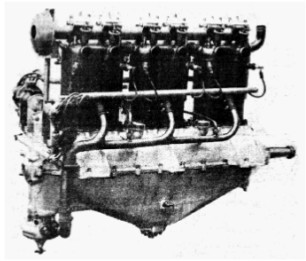
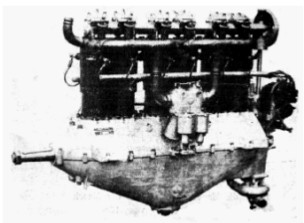
“Two views of the 100 CV engine”
-The 160 CV was made in large quantities by Mercedes from the beginning of the war. It had 6 cylinders.
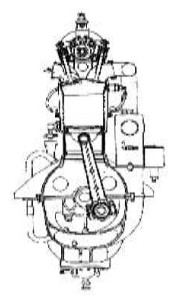
“Mercedes 160 CV cross-section”

“Mercedes 120 CV”
-In 1913 the D-I with 6 inline cylinders giving 100 CV appeared.
-That same year the D-II and D-IIa also came out with powers starting from 120 CV. Both had 6 in-line cylinders.
-Between 1914 and 1915, the D-IIIs appear delivering 160 to 170 CV.
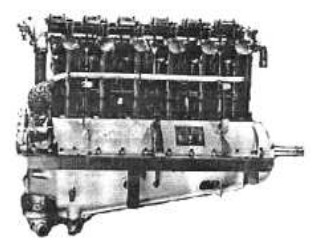
“D-III”

“D-IIIa”
-The D-IIIa is from 1916 and gave 180 CV.
-This engine could reach 200 CV depending on the rpm, the propeller, or if it had medium or high compression.
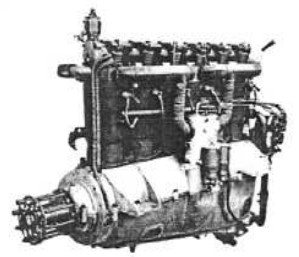
“180 CV”

“200 CV”
-In 1918 the D-IIIb appeared and turned out to be a 200 CV V8. See Daimler.
-The 240/250 CV D-IV was an 8-cylinder in-line engine from 1915 and it did not give the expected result. See Daimler.
-The D-V was an 18-cylinder W while the D-VIa was a 260/275 CV 6-cylinder. Both engines are from 1917.
-Below we show several views of the 260 CV engine, including with the special intake and exhaust manifolds, front and rear.
-In general the 6-cylinder Mercedes engines had almost the same appearance.
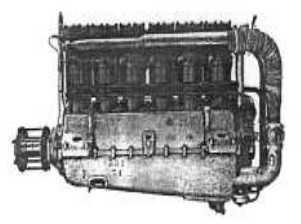
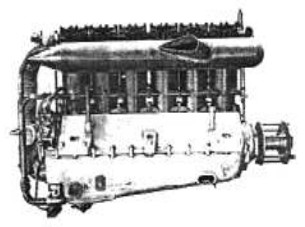
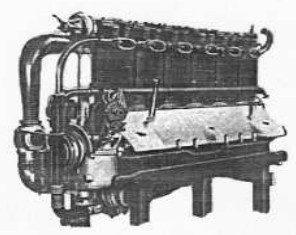

“Various 260 CV engines”
-We have seen four illustrations of the 260 CV Mercedes.
-Now we have the exact model. It is the D-IV-A with six cylinders giving 260 CV at 1,450 rpm. The pistons were 160 mm of bore by 180 mm of stroke.

“Mercedes D-IV-A at the Polito”
-This D-IV-A engine has been located in the Capetti collection at the Torino Polytechnic Institute. There is a group of more than 60 engines from WWI to WWII.
-These engines with powers of 100, 160, 180, 200, 220 and 260 CV were very similar in their architecture.
-All but the 100CV carried two exhaust valves and two intake valves.
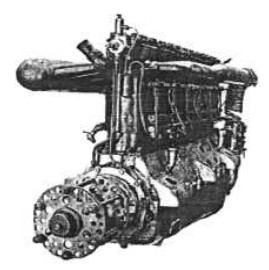
“Another 260 CV, front view”
-When WWI ended there was a lapse of time that Mercedes was not allowed to manufacture engines due to the limitations of the Treaty of Versailles.
-In that period Daimler Motoren joined Benz, becoming the Daimler-Benz Aktiengesellshaft.
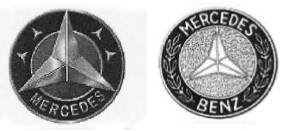
“Logos in the 1920’s”
-In 1926 they started again the manufacture of aviation engines -with limitations on the part of the old winners-. These engines were the 120 CV Mercedes models and another small one of 20 CV (the F7502), with two horizontally-opposed cylinders.
-After the surrender of Germany in WWI, the Germans were limited by the Treaty of Versailles, especially on the issue of weapons.
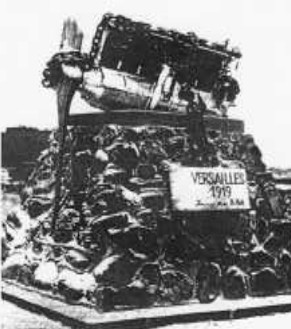
"Monument with complaint"
-Later they erected a symbolic complaint monument to such a situation, in which we see a Mercedes 180 engine, chained, evidencing such a circumstance.
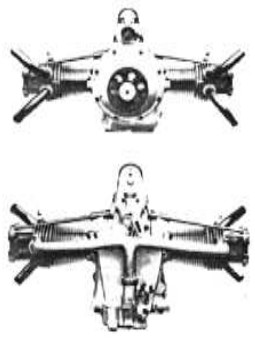
“F7502”
-Soon the production of new engines began to accelerate, such as the three-cylinder F1 radial that gave 30/40 CV.
-The F2 with 12 cylinders in V delivering 800/1,000 CV was from 1928. It had a superimposed gearbox.
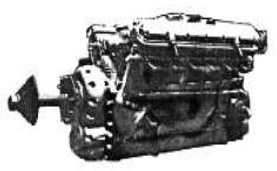

“Two views of the F2 engine”
-This engine would have its Diesel version and another variant that instead of 12 cylinders in V had 16 cylinders giving 1,200 CV.
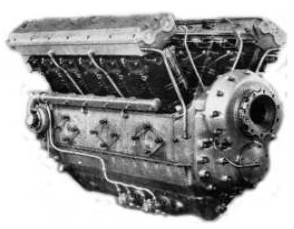
“V-12, Diesel”

“16-cylinder Diesel"
-Engines were beginning to be designed with a view to the new giant airships, and later, with their variants, we would also see them on WWII submarines.
Note: Hereafter refer to the Daimler-Benz chapter, D-B.
-Reviewing the Mercedes (and Mercedes-Benz) engines by their internal factory designation, we can see the following:
-The F-1244 was the 4-cylinder in line with 60/70 CV.
-The F-1454 had four cylinders in line giving 90 CV.
-The F-10546 with 4 cylinders in line giving 80 CV was the winner of the “Kaiserpreiss” in 1912.
-The F-1246 had six cylinders and gave 100 CV.
-The F-12556 was a water-cooled, six-cylinder that gave 125 CV.
-The F-1466 had 6 cylinders and gave 125 CV.
-The F-1468 was a six-cylinder giving 160 CV.
-The F-1686 had 6 cylinders and also gave 160 CV.
-The F-1466 DIIIa was a six-cylinder giving 180 CV.
-The F-14618 was an 18-cylinder in W. This engine had the same cylinder blocks as the F-1466. It delivered 500 CV.
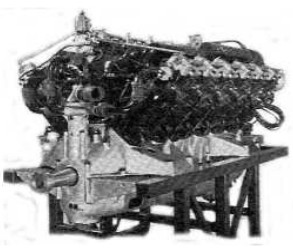
“Mercedes 18W, F-14618”
-As from 1926 the two-cylinder F-7502 with only 20 CV appears, as a result of the conditions of the Armistice.

“Better view of the F-7502”
-The F-1 of which we now have a drawing, turned out to be a radial three cylinder giving 30/40 CV.
-In the main text only their existence is mentioned, but no illustration was available.

“Mercedes F-1”
-It was known as Mercedes but remember that in those times they were also DB or Daimler Benz.
-The F-2 we already know as a V-12 of 800/1000 CV and that we now have another picture.

“Mercedes F-2”
-The OF-2 was a Diesel V-12, in fact the Daimler Benz OF-2 was an F-2 converted to Diesel with the necessary modifications. It would reach 750 CV at 1,720 rpm.
-It used a gearbox with two ratios 1.5 to 1 and 1.2 to 1.

“Mercedes OF-2”
-LOF-6 is the one that appears perfectly illustrated in the main text.
-It was the 16-cylinder Vee-engine that was used on the "Hindenburg".
-The OM65 engine was a four-cylinder Diesel auxiliary group to give 30 kW (or 60 CV). In other words, an onboard APU.
-Daimler Benz had already started using the letters DB to identify its engines.
-The DB-602 from the 600 series differed that it was an upright V-16.
-It was based on LOF-6 Diesel. It was destined for airships.
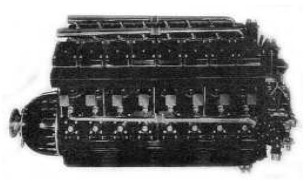
“DB-602”
From Appendix A4/6: Below we show the 70 CV engine that is mentioned in the main text without picture.
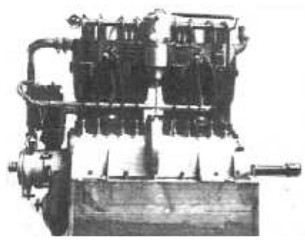
"70 CV Mercedes placed in a box"
From Appendix 6: We received two new pictures of the Mercedes 4EF, a water-cooled, four-cylinder, inverted in-line engine. This time both sides are shown.
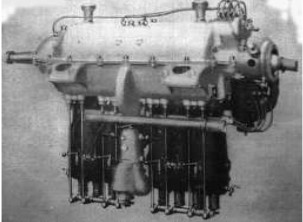
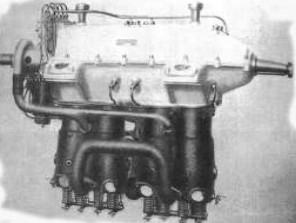
“Mercedes 4EF”
-It gives 60-70 CV at 1,400 rpm.
From Appendix 9: In 1909 this engine known as the “Mercedes-Luftschiff-Motor” was available.

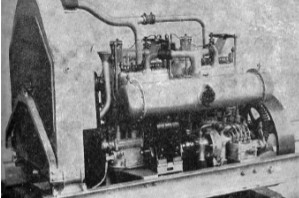
“Two views of this engine”
-It had a large cooling radiator and an important heater around the exhaust. It is supposed to be used for the services of the crew. And also for the cooling of the exhaust gases because of the intrinsic danger of lifting gas.
-Two adaptations of this brand's 800 cc car engine have been used on the Hunter UAV. One as pusher and the other as puller.
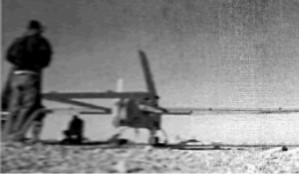
“A Hunter UAV”
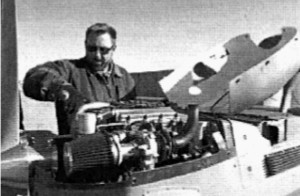
"Checking the Front Engine Oil"
From Appendix 10: -And there was the MB model, also with a flywheel.
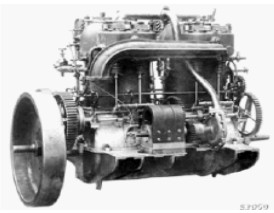
“Mercedes MB model”
-A Mercedes inverted, inline cylinder engine installed on a Rumpler airplane
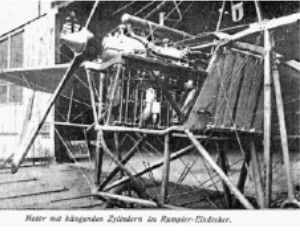
"Mercedes engine installed on a Rumpler airplane"
-Below we show a Mercedes-Benz with a supercharger for high-altitude flight -concept of the time-. It seems that it has an intercooler. (square box). On the right side a results card is shown.
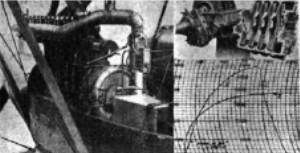
Engines of MERCEDES / MERCEDES-BENZ
Model: 4EF
Arquitecture: 4-cylinder In line inverted
Cooling: Liquid
Total Displacement:
Bore / Stroke:
Power: 70 CV @ 1400 rpm
Weight:

"Mercedes 4EF"
Model: D-II
Arquitecture: 6-cylinder In-line
Cooling:
Total Displacement:
Bore / Stroke:
Power: 120 CV
Weight:
Model: D-III, -aü, -av,
Arquitecture: 6-cylinder In-line
Cooling: Liquid
Total Displacement:
Bore / Stroke:
Power: 170 CV
Weight:
The D-IIIa gives 180 CV.

"Mercedes D-IIIa"
Model: D-IV, -a
Arquitecture: 8-cylinder In-line
Cooling: Liquid
Total Displacement:
Bore / Stroke: 160 x 180 mm
Power: 250 CV @ 1450 rpm
Weight:

"Mercedes D-IV-A at the Polito"
Model: D-V
Arquitecture: 18-cylinder W-engine
Cooling: Liquid
Total Displacement:
Bore / Stroke:
Power: 275 CV
Weight:
Model: D.I
Arquitecture: 6-cylinder In-line
Cooling: Liquid
Total Displacement:
Bore / Stroke:
Power: 100 CV
Weight:
Model: E4F
Arquitecture: 4-cylinder In-line
Cooling:
Total Displacement:
Bore / Stroke: 120 x 140 mm
Power: 75 CV @ rpm
Weight:

"Mercedes 100 CV left side view"
Model: E6F
Arquitecture: 6-cylinder In-line
Cooling: Liquid
Total Displacement:
Bore / Stroke: 120 x 140 mm
Power: 105 CV
Weight:
Model: F-10546
Arquitecture: 4-cylinder In-line
Cooling:
Total Displacement:
Bore / Stroke:
Power: 80 CV
Weight:
Model: F-1244
Arquitecture: 4-cylinder In-line
Cooling:
Total Displacement:
Bore / Stroke:
Power: 70 CV
Weight:
Model: F-1246
Arquitecture: 6-cylinder In-line
Cooling:
Total Displacement:
Bore / Stroke:
Power: 100 CV
Weight:
Model: F-12556
Arquitecture: 6-cylinder In-line
Cooling: Liquid
Total Displacement:
Bore / Stroke:
Power: 125 CV
Weight:
Model: F-1256
Arquitecture:
Cooling:
Total Displacement:
Bore / Stroke: x
Power:
Weight:
Model: F-1454
Arquitecture: 4-cylinder In-line
Cooling:
Total Displacement:
Bore / Stroke:
Power: 90 CV
Weight:
Model: F-14618
Arquitecture: 18-cylinder W-engine
Cooling:
Total Displacement:
Bore / Stroke:
Power: 500 CV
Weight:

"Mercedes 18W, F-14618"
Model: F-1466 (D-IIIa)
Arquitecture: 6-cylinder In-line
Cooling:
Total Displacement:
Bore / Stroke:
Power: 180 CV
Weight:
Model: F-1468
Arquitecture: 6-cylinder In-line
Cooling:
Total Displacement:
Bore / Stroke:
Power: 160 CV
Weight:
Model: F-1486
Arquitecture: 6-cylinder In-line
Cooling:
Total Displacement:
Bore / Stroke:
Power: 160 CV
Weight:
Model: F-1686
Arquitecture:
Cooling:
Total Displacement:
Bore / Stroke: x
Power:
Weight:
Model: F-2
Arquitecture: 12-cylinder V-Engine
Cooling: Liquid
Total Displacement:
Bore / Stroke:
Power: 1000 CV
Weight:

"Mercedes F-2"
Model: F-7502
Arquitecture: 2-cylinder Horizontally opposed
Cooling:
Total Displacement:
Bore / Stroke:
Power: 20 CV
Weight:

"Mejor vista del Mercedes F-7502"
Model: F1
Arquitecture: 3-cylinder Radial
Cooling:
Total Displacement:
Bore / Stroke:
Power: 40 CV
Weight:
Model: J4L
Arquitecture: 4-cylinder In-line
Cooling: Liquid
Total Displacement: 834 cu. in.
Bore / Stroke:
Power: 120 CV @ 1100 rpm
Weight: 660 Lb
Model: J8L
Arquitecture: 8-cylinder In-line
Cooling: Liquid
Total Displacement:
Bore / Stroke:
Power: 240 CV
Weight:

"Mercedes J8L, left side view"
Model: Le-Rhone 9C (Lic.) con Siemens
Arquitecture:
Cooling:
Total Displacement:
Bore / Stroke: x
Power:
Weight:
Model: LOF-6
Arquitecture: 16-cylinder V-Engine
Cooling:
Total Displacement:
Bore / Stroke:
Power:
Weight:
Model: MB
Arquitecture:
Cooling:
Total Displacement:
Bore / Stroke: x
Power:
Weight:

"Mercedes MB model"
Model: OF-2
Arquitecture: 12-cylinder V-Engine
Cooling:
Total Displacement:
Bore / Stroke:
Power: 750 CV @ 1720 rpm
Weight:

"Mercedes OF-2"
Model: OM-65
Arquitecture: 4-cylinder In-line
Cooling:
Total Displacement:
Bore / Stroke:
Power: 60 CV
Weight:
APU


